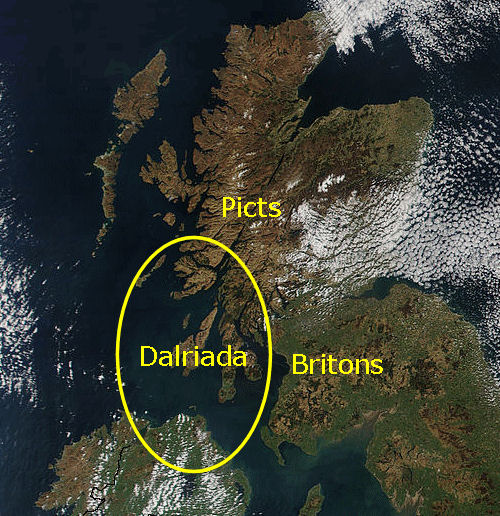The origin of the Dal Riada lies with the Conn, the ancient Iberian-Celtic tribe who gave their name to Lough Conn and to the ancient province of Connaught. By pre-Christian times, they were powerful in North Ulster and had penetrated the Pictish kingdoms on the west coast of Scotland. By Christian times, the tribe had split into an Irish-based Dal Riada and a Scottish-based Dal Riada. The tribe got its name from Cairbre Riata, son of Cormac McArt (227-266). Cairbre was the first to found a settlement of any size in Alba (the west coast of Scotland). His wife was Oileach, a Pict and relations with the Picts were largely peaceful. His son Colla Uais built up the strength of the settlement and gave his name to Clann Colla, his descendants in Alba, and also to the Maguires McConnells and McMahons in Ulster who shared that descent.
The Irish Dal Riada disappeared from history by 500, being long subsumed into Clann Colla and others. The Scots Dal Riada was centred mainly on Argyll, Kintyre and the isles south of Ardnamurcan (Kintyre was deemed to be an Isle after Magnus Barford has his ship dragged the isthmus under full sail with himself at the helm.) Their territory was overrun by Brude Kings of Picts in Colmcille’s time but in 844 under Kenneth McAlpin the Dal Riadan and Pictish kingdoms were united in the Kingdom of the Scots with the seat of government in the Pictish centres of Scone and Perth.
The Scottish Isles were occupied by the Norse and other freebooters since the earliest times and were taken over by the Norse in the period of Viking supremacy of the seas in 700-900 . In 888 Keti Hardneb, King of the Isles, threw off the rule of Harald of Norway and set himself up as the King of the Isles. Thorfin the Mighty added Caithness and the northern part of the old Pictish kingdom of Alba around 1050. These Norse rulers apparently lived in relative peace with their Gaelic tenants and neighbours giving stability to the kingdom for several hundred years. A succession of Gaelic-Pictish kings consolidated the Scots kingdom in Lowland Scotland and Strathclyde but failed to extend the kingdom into the highlands and Islands. Malcolm III was crowned King of Scotland at Scone in 1057. Following the Battle of Hastings in 1066, he married the fugitive princess Margaret, daughter of Harold and began a process of Anglicisation that took the Scots further and further away from the Norse Kingdom of the Isles and from the Gaelic clan now occupying much of the Highlands and Islands . In 1124 he was succeeded by his grandson David I who was reared in England and was fully committed to replacing the old Gaelic/Norse culture and language with an English speaking Anglo-Norman feudal system.
Around 1100 Giollabride, a nobleman of Clan Colla, returned to Scotland with a band of McColla clansmen drawn form the Irish Maguires and McMahons to restore the fortunes of McColla/Dal Riada in Argyll. In his long struggle with Olaf the Red, King of the Isles, Giollabride was supported and succeeded by his son Somerled. By 1140 the ancestral mainland of the McGillvarrys and the MacInnes were under Somerled’s rule and Somerled was married to Ragnhilda, daughter of Olaf the Red ,King of the Isles. In 1156 Somerled defeated Olafs successor Godred and took Kintyre and all the isles south of Ardnamurcan. In 1158 he again defeated Godred who fled to Norway leaving Somerled undisputed King of the Isles nominally subject to the king of Norway, and to Malcolm of Scotland for his Argyll dominions. In 1164, incensed at Malcolm IV’s Norman plantation of Gaelic territory in Galloway and Moray he led his army to Glasgow where he was murdered by his valet, Maurice McNeil at the instigation of Malcolm. The Lordship of the Isles was forfeited by John in 1494 and passed to the son of the English monarch. The Lordship line died out with the death of Donald Dubh McDonnell at Drogheda in 1545.

